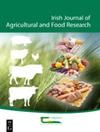提高肌肉脂肪酸剖面的牧场整理在奶牛源小牛到牛的牛肉生产系统及其潜力,以验证牛的饮食历史
IF 1.4
4区 农林科学
Q3 AGRICULTURE, MULTIDISCIPLINARY
引用次数: 0
摘要
研究了改良传统24月龄奶牛犊牛对牛肉生产系统最长肌脂肪酸组成的影响及其鉴定牛肉来源的潜力。从3月到8月,54头与荷尔斯坦-弗里西亚(HF)、阿伯丁·安格斯(AA)和比利时蓝(BB)公牛配种的荷尔斯坦-弗里西亚奶牛的后代在牧场上进行3(品种类型)× 3(肥育策略)的析因试验,每个父系品种18头。这三种育肥策略分别是:(i)屠宰前(21月龄)94 d仅放牧(草),(ii)屠宰前(21月龄)94 d在室内自由浓缩(EC)和(iii)屠宰前94 d仅放牧,然后屠宰前(24月龄)98 d在室内自由浓缩(LC)。与欧共体相比,草料肌肉的肌内脂肪浓度和omega-6: omega-3多不饱和脂肪酸(PUFA)比例较低,共轭亚油酸比例较高。较长的牧草预精育期提高了饲粮中omega-3 PUFA的浓度,但仍低于牧草。为了最大限度地提高omega-3 PUFA浓度,晚熟品种更合适,而最大限度地提高共轭亚油酸,早熟品种更合适,两者都应该在草地上完成。化学计量学分析证实,脂肪酸谱可以鉴别“草肥”牛肉本身,并有可能根据肥育前的放牧时间区分“精肥”牛肉,但不能区分父系品种。本文章由计算机程序翻译,如有差异,请以英文原文为准。
Enhancing muscle fatty acid profile by pasture finishing within a dairy-origin calf-to-steer beef production system and its potential to authenticate the dietary history of the cattle
The influence of modifying a traditional 24-mo dairy steer calf to beef production system on the fatty acid composition of the longissimus muscle and its potential to authenticate beef provenance was examined. Fifty-four male calves (n = 18 per sire breed), progeny of Holstein-Friesian cows mated with Holstein-Friesian (HF), Aberdeen Angus (AA) and Belgian Blue (BB) bulls were at pasture from March until August of their second year when they were assigned to a 3 (breed types) × 3 (finishing strategies) factorial experiment. The three finishing strategies were (i) pasture only for a further 94 d prior to slaughter (21 mo of age) (Grass), (ii) concentrates ad libitum indoors for 94 d prior to slaughter (21 mo of age) (EC) and (iii) pasture only for a further 94 d followed by concentrates ad libitum indoors for 98 d prior to slaughter (24 mo of age) (LC). Compared to EC, muscle from Grass had a lower intramuscular fat concentration and omega-6: omega-3 polyunsaturated fatty acid (PUFA) ratio and higher proportion of conjugated linoleic acid. A longer period at pasture pre-concentrate finishing increased the concentration of omega-3 PUFA which was still lower than in Grass. To maximise the omega-3 PUFA concentration, a late-maturing breed is more appropriate while to maximise conjugated linoleic acid, an early-maturing breed is more appropriate and both should be finished on grass. Chemometric analysis confirmed that the fatty acid profile can authenticate “Grass-Finished” beef per se and has potential to distinguish “Concentrate-Finished” beef based on the length of grazing prior to finishing, but not distinguish between sire breeds.
求助全文
通过发布文献求助,成功后即可免费获取论文全文。
去求助
来源期刊
CiteScore
2.50
自引率
20.00%
发文量
23
审稿时长
>36 weeks
期刊介绍:
The Irish Journal of Agricultural and Food Research is a peer reviewed open access scientific journal published by Teagasc (Agriculture and Food Development Authority, Ireland). Manuscripts on any aspect of research of direct relevance to Irish agriculture and food production, including plant and animal sciences, food science, agri environmental science, soils, engineering, buildings, economics and sociology, will be considered for publication. The work must demonstrate novelty and relevance to the field of research. Papers published or offered for publication elsewhere will not be considered, but the publication of an abstract does not preclude the publication of the full paper in this journal.

 求助内容:
求助内容: 应助结果提醒方式:
应助结果提醒方式:


